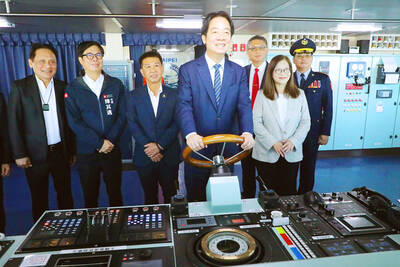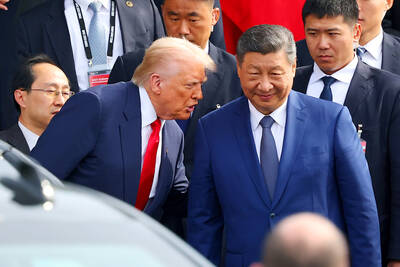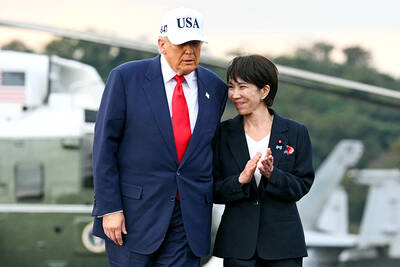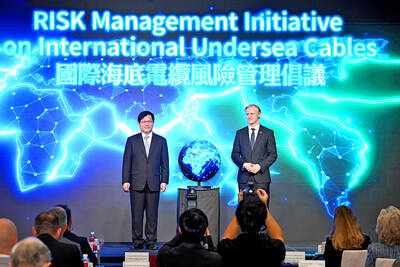A Chinese fighter jet was flying below the US EP-3 propeller plane when the spy plane banked to the left, the Washington Post said yesterday quoting Western sources in Beijing.
Briefed by US officials, the unidentified sources did not make clear who was to blame for Sunday's mid-air collision over the South China Sea that forced the US spy plane to make an emergency landing on China's Hainan island, where its 24 crew members were taken into custody.
However, the sources said the data provided by US officials seems to explain China's assertion that the incident was the fault of the US because the EP-3 moved "suddenly" causing the accident.
The accident led to the fighter's crash into the sea and the disappearance of its pilot.
Earlier accounts of the accident indicated that the EP-3 had been intercepted by two Chinese F-8s, but no public mention was made of the Chinese jet's position beneath the US spy plane, or the US plane's banking maneuver to the left.
The Western sources also said that after the bump, the spy plane fell 2,440m before the pilot succeeded in righting it.
At that point, the sources added, the US crew began destroying sensitive software and data in the plane to prevent it falling into Chinese hands.
The US spy plane, a Pentagon official said, made an extremely fast landing at Lingshui air base on Hainan, because the pilot feared the collision might have damaged his controls and that only one of his flaps (which brake the plane on descent) may have been working.
After it had come to a rest, the US plane was surrounded, then boarded by Chinese guards who escorted the 24 US airmen at gunpoint off the plane, the Western source said.
A day later, the source said, the Chinese army dispatched a cargo plane loaded with men and technical equipment from Beijing to the base to study the US aircraft.
In related matters, US Senator Richard Lugar said yesterday that the pilot of the lost Chinese jet had challenged the US plane on previous occasions.
"It appears to me on this occasion he simply exceeded his grasp," Lugar said of the Chinese aviator: "The pilot involved is apparently the same pilot who's been observed by our reconnaissance aircraft in the past."
Lugar spoke yesterday on US television. "The flight we were flying is a regular flight, known to the Chinese, known to the Indians, the Pakistanis, everyone in the area," he said. "So there were very few surprises with this lumbering plane moving along." Nevertheless, Lugar said, in recent days Chinese fliers, "and this particular pilot on several occasions," had challenged the surveillance flight.
"It is tragic for him and tragic for the Chinese and tragic for us, because it was only a miracle that our plane got down safely and the 24 Americans are still alive," Luger said.
Former Defense Secretary William Cohen said the US had previously protested the practices of Chinese interceptor pilots.
"A very strong protest was lodged back in January [over] these fighter aircraft coming within a matter of feet of reconnaissance aircraft, thereby posing a danger to all concerned. That apparently is what happened here," Cohen said.

CALL FOR SUPPORT: President William Lai called on lawmakers across party lines to ensure the livelihood of Taiwanese and that national security is protected President William Lai (賴清德) yesterday called for bipartisan support for Taiwan’s investment in self-defense capabilities at the christening and launch of two coast guard vessels at CSBC Corp, Taiwan’s (台灣國際造船) shipyard in Kaohsiung. The Taipei (台北) is the fourth and final ship of the Chiayi-class offshore patrol vessels, and the Siraya (西拉雅) is the Coast Guard Administration’s (CGA) first-ever ocean patrol vessel, the government said. The Taipei is the fourth and final ship of the Chiayi-class offshore patrol vessels with a displacement of about 4,000 tonnes, Lai said. This ship class was ordered as a result of former president Tsai Ing-wen’s (蔡英文) 2018

UKRAINE, NVIDIA: The US leader said the subject of Russia’s war had come up ‘very strongly,’ while Jenson Huang was hoping that the conversation was good Chinese President Xi Jinping (習近平) and US President Donald Trump had differing takes following their meeting in Busan, South Korea, yesterday. Xi said that the two sides should complete follow-up work as soon as possible to deliver tangible results that would provide “peace of mind” to China, the US and the rest of the world, while Trump hailed the “great success” of the talks. The two discussed trade, including a deal to reduce tariffs slapped on China for its role in the fentanyl trade, as well as cooperation in ending the war in Ukraine, among other issues, but they did not mention

Japanese Prime Minister Sanae Takaichi yesterday lavished US President Donald Trump with praise and vows of a “golden age” of ties on his visit to Tokyo, before inking a deal with Washington aimed at securing critical minerals. Takaichi — Japan’s first female prime minister — pulled out all the stops for Trump in her opening test on the international stage and even announced that she would nominate him for a Nobel Peace Prize, the White House said. Trump has become increasingly focused on the Nobel since his return to power in January and claims to have ended several conflicts around the world,

GLOBAL PROJECT: Underseas cables ‘are the nervous system of democratic connectivity,’ which is under stress, Member of the European Parliament Rihards Kols said The government yesterday launched an initiative to promote global cooperation on improved security of undersea cables, following reported disruptions of such cables near Taiwan and around the world. The Management Initiative on International Undersea Cables aims to “bring together stakeholders, align standards, promote best practices and turn shared concerns into beneficial cooperation,” Minister of Foreign Affairs Lin Chia-lung (林佳龍) said at a seminar in Taipei. The project would be known as “RISK,” an acronym for risk mitigation, information sharing, systemic reform and knowledge building, he said at the seminar, titled “Taiwan-Europe Subsea Cable Security Cooperation Forum.” Taiwan sits at a vital junction on